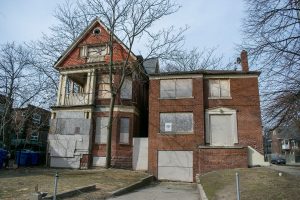When preservation leads to deterioration

Designated a heritage property by the City of Toronto, crumbling and neglected 6 Walmer Rd. is causing problems for its neighbours. AHMED-ZAKI HAGAR/GLEANER NEWS
By Ahmed-Zaki Hagar
At over 120 years old, 6 Walmer Rd. is at once a crumbling symbol of the area’s rich history and, a sign of the city’s inability to protect its built heritage. And it’s causing no small amount of problems for the neighbours.
“When I initially moved [here], it was not an issue. It was an abandoned house,” said Neil Jain. “Over the years, it has been deteriorating. There have been a number of issues.”
These include litter that attracts rats and other pests, graffiti covering the house, and a type of loitering best left to the police to handle. Then there’s the hole in the roof, which has been there since at least February.
Built in the Queen Anne style, which was popular in the Annex in the late nineteenth century, 6 Walmer Rd. was originally number 2 Walmer Rd. and designed by architect Frederick Henry Herbert for Presbyterian minister Thomas Goldsmith and his family in 1896. It’s one of five Walmer Road properties designed by Herbert designated as a heritage property under the Ontario Heritage Act.
Many houses of a similar style in the area were replaced by apartment towers during the latter half of the twentieth century, but 6 Walmer Rd. remains — boarded over, covered in graffiti, and a hazard to the neighbourhood.
Sandra Shaul, chair of the Annex Residents’ Association’s (ARA) heritage committee, described it as the “highest-profile negligence problem in the Annex”.
“Over the years, we filed 311 requests for garbage, for graffiti, for various issues,” said Jain. “A lot of times, especially in the past couple of years, I have seen it would take weeks or months before any action is taken.”
Shaul said that sometime after she moved into the neighbourhood 32 years ago, somebody bought the property and fixed it up so “that it looked better than new. It was beautiful.”
However, when 6 Walmer Rd. was rented, according to Shaul, there were issues between the owner and the tenant, which was where the problems began.
Jain contacted Albert Koehl, environmental lawyer and vice-chair of the ARA, who investigated further into the matter.
“When I saw what the condition of it was and heard from the neighbour, I was quite disappointed to see little action by the City [of Toronto] in terms of ensuring that the property owners keep the property protected,” he said.
Koehl sent a list of bylaws from the Toronto Municipal Code that the owner of 6 Walmer Rd. was violating, such as maintaining the heritage property’s “character, visual, and structural character”. Other bylaws state owners must minimize damage from natural causes or neglect.
The municipal code says owners can protect their property by boarding up all doors and windows to prevent people and animals entering the property.
Municipal Licensing & Standards enforces the bylaws for maintaining heritage properties, but Koehl questions how committed the city is to heritage preservation if it does enforce its own bylaws.
“After doing all of [the work of researching a property and designating it], there does not seem to be any kind of follow-up, enforcement, or interest,” he said.
Adding to the problem is that it’s not clear who owns on the property, as there’s conflicting information on the public record. According to the Ontario Land Registry, the City of Toronto owns 6 Walmer Rd., which is confirmed by an official from Municipal Licensing & Standards. However, a search of the Municipal Property Assessment Corporation database yields different information, and lists the owner as NSCL Investments Limited. And there’s a record of an owner applying to demolish the property in 2011, an application that was refused even though a staff report did state that there was “concern for the future of the site”.
Shaul said the city should secure the house to prevent further damage, and invest in its restoration.
“Even if it were not a heritage site, you do not want a house in that state in your community,” she said. “It becomes a beacon for vagrancies, for drug deals, for pests. That should not be permitted.”
It appears that it’s not the only property in the area lost in a limbo of preservation and deterioration.
“Another one is 10-14 Prince Arthur Ave., and if you look at it, that is really a sad story,” said Shaul. “That house is the last of the Yorkville houses, those wonderful white houses that were characteristic of Yorkville in the early 1800s.”
As the house’s ownership switched hands over the years, the property began to deteriorate. Today, 10 Prince Arthur Ave. is fenced with its windows barricaded by bricks and its white paint falling off.
“When you see that house and you think of what it looked like through the years, you would want to cry,” said Shaul. “Any city with any civic pride would insist that people keep up a minimum standard of maintenance.”
Neither Heritage Preservation Services nor Municipal Licensing & Standards responded to repeated requests for comment.
READ MORE ON HERITAGE ISSUES:
CHATTER: Kensington Market HCD enters planning phase (Nov. 2017)
CHATTER: University to appeal Ten Editions heritage designation (MAY 2017)
NEWS: Restored Brunswick House reopens (May 2017)
NEWS: Kensington Market to become heritage district (May 2016)
NEWS: Mad House: Madison dweller alleges harassment over heritage home (Nov. 2010)

1 response so far ↓
1 Twentyfour MacPhersonavenue // May 22, 2018 at 10:04 am
Please take a look